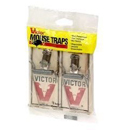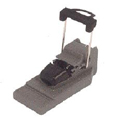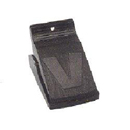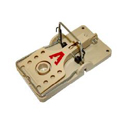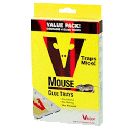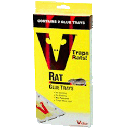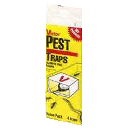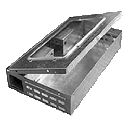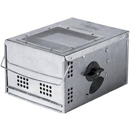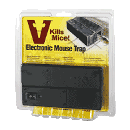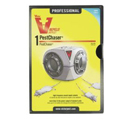|
Common Rodents of
North America
Everything you need to know about mice and rats
and how to control them
Click on a picture below to learn about that rodent
Why are they in my house?!?
Mice get into everything. If they have found an easy source of food,
then they won’t want to leave. They could also be trying to get out
of the cold and into your warmth. House mice primarily feed on plant
matter, but they will also accept meat, dairy products, or just
about anything they can tear open and stuff in their mouths. They
will drink water but require little of it, relying mainly on the
moisture present in their food. They will eat their droppings to
acquire nutrients produced by bacteria in their guts. House mice,
like other rodents, do not vomit.
Where are those little guys hiding?
Mice are mostly active during the night. They live in a wide variety
of hidden places that are near food sources and construct nests from
various soft materials. Mice are territorial and one dominant male
usually lives together with several females and young. Dominant
males respect each other's territory and normally enter another's
territory only if it is vacant.
 Oh,
the damage they can
do… Oh,
the damage they can
do…
House mice can transmit diseases, and can damage food and food
packaging. They can also cause substantial damage when feeding on
grain. They carry diseases such as Lyme disease and Hantaviruses,
which cause severe illness in humans. It is thought that house mice
were the primary reason for the taming of the domestic cat. Various
mousetraps have been developed to catch mice. Generally, rats are
more harmful to humans than mice. Each year, rodents cause more than
one billion dollars in damage in the United States alone
 Take
care of a mouse problem earlier rather than
later… Take
care of a mouse problem earlier rather than
later…
Mice can go from a small problem to a very large one in no time. A
female mouse has an average litter 6-8 young. One female can have
some 5-10 litters per year and they can reach sexual maturity within
five weeks, so their population can increase very quickly!
Invasion of the House Mice???
Gough Island in the South Atlantic is used by 20 species of seabird
for breeding, including almost all of the world's Tristan Albatross
and Atlantic Petrel. Until house mice arrived on the island in the
19th century with seamen, the birds did not have any mammalian
predators. The mice have since grown unusually large and have
learned to attack albatross chicks, which can be nearly one meter
tall but are largely immobile, by working in groups and gnawing on
them until they bleed to death. The estimated 700,000 mice on the
island kill a total of over 1 million bird chicks per year!
The Deer Mouse is distantly related to the common house mouse and
has the same basic living style and destructiveness of the common
house mouse. The deer mouse is common in the American Southwest,
particularly in New Mexico, where the species is known to carry
Hantavirus.
The White-footed mouse has many of the same habits as the common
house mouse. It ranges from the northeast United States to the
southwest and Mexico. This species is similar to Peromyscus
maniculatus, the Deer Mouse in looks, but contrary to popular belief
it is not the same mouse. Like the deer mouse, it may
carry Hantaviruses, which cause severe illness in humans. It has
also been found to be a carrier for the Lyme disease causing
spirochete, Borrelia burgdorferi.
Where do they come from?
The Brown Rat is one of the best known and most common rats, and it
is conveniently one of the largest. This little creature has
followed humans to every continent except Antarctica. And if you
have any food in your house at all, they could easily be there to
eat it.
What do they look like?
The fur is coarse and usually brown or dark grey, while the under
parts are lighter grey or brown. They can be up to 10 in. long, with
the tail another 10 in. longer. Males weigh an average of 12 oz. and
females are about 9 oz.
What do Brown Rats eat?
The brown rat is a true omnivore and will consume almost anything.
Their favorite foods in order are scrambled eggs, macaroni and
cheese, and cooked corn kernels. Their least favorites are raw
beets, peaches, and raw celery.
What are they doing?
The Brown Rat is usually active at night and is a good swimmer, both
on the surface and underwater, but unlike the related Black rat they
are poor climbers. Brown rats dig well, and often excavate extensive
burrow systems.
Rats Laughing???
Rats may also emit short, high frequency, ultrasonic, socially
induced vocalization during rough and tumble play, before receiving
morphine, or having sex, and when tickled. The vocalization is
described as a distinct "chirping," has been likened to laughter,
and is interpreted as an expectation of something rewarding. Like
most rat vocalizations, humans cannot hear the "chirping" without
special equipment. In clinical studies, the laughter is associated
with positive emotional feelings, and social bonding occurs with the
tickler, resulting in the rats becoming conditioned to seek the
tickling. However, as the rats age, there appears to be a decline in
the tendency to laugh.
House Rat (Black Rat, Ship Rat, or Roof Rat)
What’s the difference between a Black rat and a Brown Rat?
Black rats a poor swimmers and great climbers, while Brown rats are
great swimmers and poor climbers. This means that if you have rats
in your attic, it’s probably a Black rat, while if you find tunnels
or nest near water then its probably a Brown rat. Both types of rats
are similar in size, but black rats are on average an inch shorter
in length. And of course let us not forget that one is black while
the other is brown.
How they got to your house from Asia…
The Black Rat originated in tropical Asia and spread through the
Near East in Roman times before reaching Europe by the 1500s and
spreading with Europeans across the world. Today it is largely
confined to warmer areas, having been replaced by the Brown Rat in
cooler regions.
Rats acting like dogs…
It is common for rats to groom each other and sleep together. As
with dogs, rats create a social hierarchy, and each rat has its own
place in the pack. There is always a dominant rat. Groups of rats
tend to "play fight", which can involve any combination of jumping,
chasing, tumbling, and boxing. Play fighting involves rats going for
each other's necks, while serious fighting involves strikes at the
others' back ends.
Interesting Fact…
A rat's temperature is regulated though its tail and if they get too
hot they will lay on their back so that they can "sweat" through the
soles of their feet. Also, mice are afraid of rats, which often kill
and partially eat them.
Sometimes, rats and mice can become a very destructive nuisance to
humans. They can get in to food, destroy plastic and paper objects
for building nest, and carry diseases that can easily make us very
sick. There are several methods available for ridding your home or
office of these creatures. I have made a list of all the types of
rodent control products that I could find. See which one would work
best for you. All the products are linked to an online seller if you
would like to buy them.
Rodent Poison Baits
I do NOT recommend poison baits to kill rats or mice. After a rat
eats the poison it will crawl to into a place to die. That place
usually ends up being inside the walls of your home. If you have
never had the "joy" of smelling a dead rat for days, I don't
recommend it. Another reason for not using poison baits is that a
pet or child could get into that same poison which would create a
potentially life threatening situation.
Regular mouse traps
I'm sure most of you know what I mean by regular mouse traps. We all
have seen the traditional wooden mouse trap with the metal
spring. There is now other options available that will kill rodents
quicker or are easier to set. If you want more information on a
trap, you can click on it and it will take you to a website that you
can buy them from.
Mouse and rat glue traps
Glue traps are one of the most popular forms of rodent control. They
are usually a tray or piece of thick paper that has a really sticky
glue on it. You can use large glue traps that are meant for rats on
both rats and mice. Just don't use a mouse glue trap to catch a rat
because it is bigger and will be able to move the glue trap around
and might pull itself off. If you just leave the rodent on the glue
pad, it will die of dehydration and you can throw it away. You can
also catch and release the rodent far from your house. Just pour
vegetable oil or orange oil on the glue trap and it takes away the
stickiness so that the rodent can free itself.
Live catch mouse traps
If you want to catch and release mice instead of killing them, then
you should use these types of traps. Most are just a simple metal or
plastic box with a mechanism that lets mice in but not out. Some
traps come pre-baited and others require you to add your own inside
the trap. After you catch that troublesome creature, you can take it
out to a field or other location far from your home.
Electronic mouse and rat traps
These traps are your most expensive but also the easiest and most
effective to use. You just put whatever bait you want in the trap
and the rodent will come along get zapped and die. Clean up is not
very messy and you don't have to reset the trap. The traps usually
run on AA, C, or D batteries and last for a while without having to
replace them.
Sonic rodent repellents
Sonic repellents are little electronic devices that you plug into
the wall or have batteries. They emit a high frequency sound that
only mice and rats can hear. This noise is so annoying to them that
it acts as a repellent. This method is a more expensive yet less
messy method to prevent rodents from being in your home.
Organic repellents
Some companies make organic repellents. These are usually some type
of powder or liquid that you put around areas that rodents keep
getting into. A perfect use for this type of rodent control would be
around trash cans outside. Be sure that you use an organic repellent
though because you don't want any pets or children getting into
poisons.
Testimonials
Product: Victor Tin Cat
Buyer: Cat Lover (Louisville, GA)
Comments: We had a mouse in our kitchen and did not have the
heart to kill it. We set these traps and within 4 hours we
had caught the mouse. We baited it with a cracker and he
walked right in. It was also very easy and clean to release
him. Would recommend if you are not in to killing the mouse
but want the mouse removed neatly. Also was perfect because
I have a cat but did not want the cat to eat the mouse. The
trap kept the two separated.
Product: Electronic Mouse Trap
Buyer: T. Parkman (Berkley, Massachusetts)
Comments: I bought this trap several years ago from a home
Improvement catalog and I've caught so many mice with it
that I can't even count. Right now it has a broken hinge so
the door comes off in your hand and I have a wooden match
stick jammed in the trip switch and it still works
fantastic. Make sure you check this trap everyday so you
don't get a decayed mouse in it because it's hard to get the
smell out which will deter another mouse. The green light
will blink for I think twenty four hours before it goes out
indicating a caught mouse so you have plenty of time to
check it. The red light will blink if the batteries need
replacing which isn't that often. This works very nicely and
i highly recommend it over other traps because of it's
simplicity and ease of use.
Product: Power Kill Mouse Trap
Buyer: J. McCormick (Virginia)
Comments: This mousetrap is the easiest trap to use I have
found. I had no success with the standard wooden traps, the
"humane" traps that simply catch them to be released, or the
glue traps; however, once I had this one set, I had my mice
in a day. This trap is a little more heavy-duty than the
standard traps. It's all plastic and metal (no wood). There
is also virtually no chance of setting the trap off on
yourself while you attempt to bait it for the mice. An ideal
trap.
|
About Us
We
strive to offer our customers the absolute best service to accompany
the highest quality products. Everything you buy has a money back
guarantee if you are not satisfied. Right now we carry a large
variety of organic insecticides and fertilizers, but we are
expanding to multiple lines of "natural living." For more information on
rodents or other home and garden pest, visit us at
www.IamOrganic.com.
Have a Question?
Email us ANY question you have about our products or problems
you are having around your home.
We are here to help...
Support@IamOrganic.com
Like this Website???
Check out our others:
Informational Sites:
http://www.deer-rabbit.com/
http://www.flea-control.org/
http://www.agturfproducts.com/
Blogs:
http://www.iamorganic.com/blog/index.php
http://iamorganic.wordpress.com/
Product Websites:
http://www.IamOrganic.com
http://www.Organic-Gardening-Shop.com
http://www.AgOrganics.com

Model #'s
VM240,
V141,
V133,
V144,
V172,
V174,
V184,
V308,
V408,
V417,
V411,
V252,
V240,
VM753,
VM792,
DT3726
|
